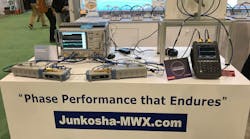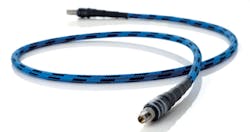Is the performance of cables and interconnects one of the greatest barriers to delivering a 5G world?
Fifth-generation wireless, or 5G as it’s more commonly known, is the latest iteration of cellular technology, engineered to greatly increase the speed and utility of wireless technology. 5G isn't just an incremental improvement over 4G—it's the next major evolution of mobile communication technology with performance improvements of an order of magnitude over today's networks. 5G does not replace 4G—it simply enables a wider diversity of tasks that 4G alone cannot perform. 4G will continue to advance in parallel with 5G as the network to support more routine tasks. The new high-frequency network will enable services that are yet to be imagined as connected technologies touch every aspect of our lives.
Joe Rowan is President and CEO, USA and Europe at Junkosha.
Beyond the fundamental but highly technological challenges of ensuring that the 5G network will work, a number of significant hurdles will need to be overcome by operators. For example, spectrum availability is not limitless. With the radio frequencies of 3G and 4G becoming increasingly crowded, 5G will have to operate at even higher frequencies to deliver the faster data speeds. This brings into play the millimeter-wave (mmWave) band, which has its own unique challenges with issues of reliability and ruggedness of cabling.
Interconnects have gained a reputation as the weakest link in a system, especially when operating at the limit of performance. A new generation of cables has been developed that will stand up to the rigors of higher frequencies and environments with high temperature and flexure. The challenge of companies like Junkosha that deliver these solutions is: How do we change engineers’ perceptions of cabling and interconnects into the future?
What are the demands of this mmWave world?
To meet the higher speed and capacity demands, 5G will have to turn to mmWave frequencies to be successful. With capacities of up to 1.4 Gb/s at a median speed of 28 GHz, 5G will be as much as 10 times faster than the previous incumbent (4G). This step change in speed brings with it demands and complications never witnessed before.
Today, the demand for mmWave frequencies is no longer the preserve of military and research applications; instead, it’s now being demanded in mainstream technologies like 5G. The requirement for high-speed data applications are driving innovations in today's technology-driven world.
At the higher mmWave frequencies, “phase performance that endures” is a statement that the cabling and interconnects must live up to, especially in the test-and-measurement environment. At these frequencies, interconnects are very small, meaning that connector design is not trivial. In addition, the amount of bending and stress the cabling endures is significant, resulting in an environment that requires phase-stable cables to be installed.
After all, if the cabling is the first thing to let the engineer down, it remains the most system-critical element in terms of reliability. This is why it’s so important that engineers use cabling and interconnects built for the 5G world.
Do the characteristics of the cables required for mmWave frequencies need to be of higher quality?
The short answer to this question is yes—the interconnects used should be of the highest quality to withstand the rigor they are put through in each scenario. Examples include the system development or device characterization phases where precision and repeatability are required, as well as in the stages of commissioning the overall system and monitoring during the production test environment.
At the mmWave level, the connector designs used are very small—2.4 mm down to 1.85 mm and even 1 mm is now required. These small sizes have a considerable effect on the engineer's ability to transition from the connector to the cables, which needs the highest levels of precision and accuracy to implement. On completion of this task, the next activity is to test the assemblies in a test environment, using such equipment as a vector network analyzer (VNA). Here, instances of flexure and movement significantly impact the accuracy of results, which is accentuated as frequencies increase.
At this miniaturized, high-frequency level, the quality of the cables and the connectors used must be of the highest order. The reason is very simple: With cheaper alternatives, the cabling often lasts less than a year, meaning replacements are required on a frequent basis. With high-end cabling and interconnects, such as Junkosha's MWX051 and MWX061 (Fig. 1), engineers can rigorously test for periods of approximately three and a half years.1
1. The MWX061 cable can be used at frequencies as high as 67 GHz.
What are the key challenges to the assembly or interconnect manufacturer?
5G is foremost about enhanced mobile broadband, requiring much greater throughput than its 3G or 4G predecessors. The vision for 5G includes ultra-low-latency speeds to enable futuristic applications, such as the heralded potential benefits of connectivity across smart cities and autonomous transport. However, implementing 5G has many significant challenges, not the least of which is exploiting mmWave frequency bands, which has proved a major step.
At the mmWave frequency level, path loss presents a key issue. Obstacles such as vegetation, walls, and even glass, as well as the general interference encountered in urban environments, all have a major effect. In addition, to enable a future of machine-to-machine communications—which ultimately means far more connected devices than we have today—greatly reduced latency is required to enable real-time applications. Lastly, the requirement to generate much more power presents a considerable hurdle for the interconnect manufacturer, since a higher insertion loss is a fact of life at the mmWave level for cable assemblies.
Another consideration for everyone operating in the 5G sector is the current lack of standards. Although these are anticipated, nothing is likely until the end of 2018 at the earliest. Even then, this will only be the start; more will come as we develop the technologies required over the course of 2019 and 2020. Therefore, the operators in this market must sort out the essential 5G features and functionalities without an appreciation of what standards they will have to meet, which isn't ideal. From a cable manufacturer’s perspective, we must be sensitive to the end user’s need for a system that will not only operate at the mmWave frequencies, but also perform at the highest standards and remain compliant.
Interconnects for the 5G world must be flexible, repeatable, and durable to withstand an environment that will test them beyond their limits. These requirements are not easy to meet, and it takes considerable precision and expertise to create a cabling solution that engineers will be hard-pressed to improve upon.
Has Junkosha Developed a Solution?
Junkosha has been developing very high-frequency interconnects since the 1980s. Collaborating with Gore, the team created a mmWave dielectric waveguide. At that time, the applications were unique bespoke projects, often within the defense sector.
Earlier this year, at IMS 2018, Junkosha launched its MWX051 and MWX061 interconnects that target a new era of high-frequency communications (Fig. 2). Reaching frequencies up to 70 GHz, these next-generation cabling solutions provide engineers with the highest-quality phase-stable interconnects designed to withstand the most rigorous of testing environments for periods of up to three years. Featuring high tensile strength, a low dielectric constant, and high flex life thanks to the company’s precision-engineered expanded-PTFE tape-wrapping technology, these new interconnects will test engineer’s resolve to stick with lower-quality, lower-cost alternatives.
2. Junkosha’s MWX051 and MWX061 cables were on display at IMS 2018.
With these new solutions, original equipment manufacturers (OEMs) operating in the 5G arena are better able to test their systems with confidence and longevity in mind.
How have they achieved phase stability on these high frequencies?
Expanded-PTFE is the key material needed to deliver high tensile strength, a low dielectric constant, and high flexure, the desired attributes that are vital for mmWave data communications. At the core of Junkosha's innovations are the company's fluoropolymer expertise and precision engineering that enables this unique expanded PTFE tape-wrapping technique.
This technique, uniquely implemented by only two manufacturers in this space, allows Junkosha to deliver a flexible cabling assembly at these high frequencies that provides “phase performance that endures” over time.
What does the future hold?
5G is set to completely transform the way we do business. Bringing enormous data capacity, rapid speeds, and incredibly low latency, 5G marks a huge step up from its 4G predecessor.
The future is a connected future, with millions more connected devices set to enter the marketplace. Not only will it boost efficiency, but it will also enable us to explore developing technologies well into the 2020s and 2030s. Anticipated technologies include connected and autonomous cars, smart cities, and the Internet of Things (IoT), all of which will bring a huge amount of devices that require connection to the wireless network for the operation of immersive entertainment (virtual and augmented reality). Furthermore, thanks to unprecedented transfer speeds, they will be able to realize the benefits of big data.
The reason for looking to the future is that, whether we like it or not, 5G is part of all our futures, and we need to embrace it. And it won’t stop there. We are continually asked for cabling solutions that take us beyond current speeds and frequencies, moving us to a world we can barely imagine.
However, with significant change comes significant challenges that will affect everyone. The cabling and interconnects, often cited as the weakest link of many systems, is one such area in need of innovation. Operating at mmWave frequencies since the mid-1980s, Junkosha was one of the organizations that foresaw the need for these high-end frequencies beyond just the military. Innovating the future through technologies for 5G will bring about a wireless network that will change the mobile telecoms space forever.
Reference:
1. This is based on an internal tick-tock test of 30,000 cycles, which equates to 30 tests per day, five days per week, for 3.8 years.




